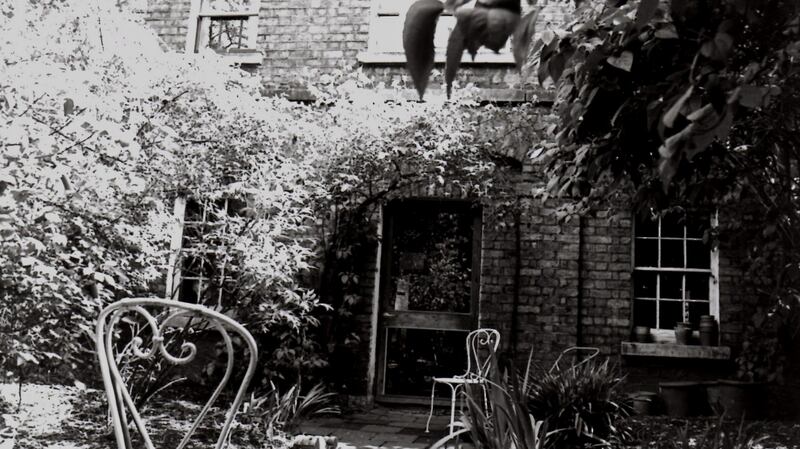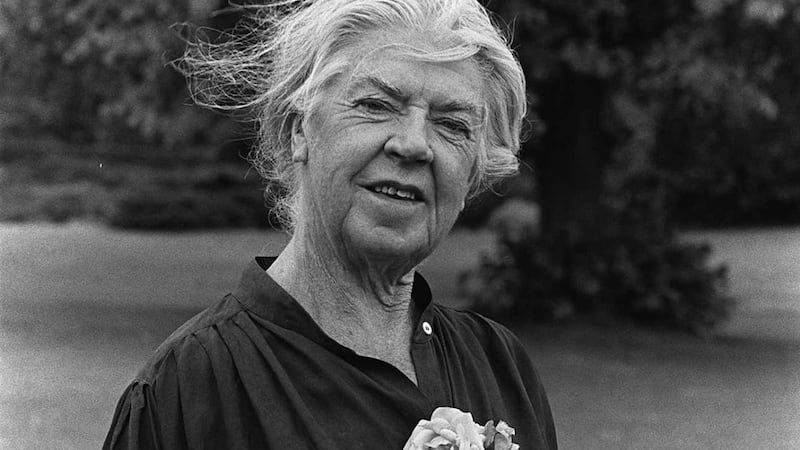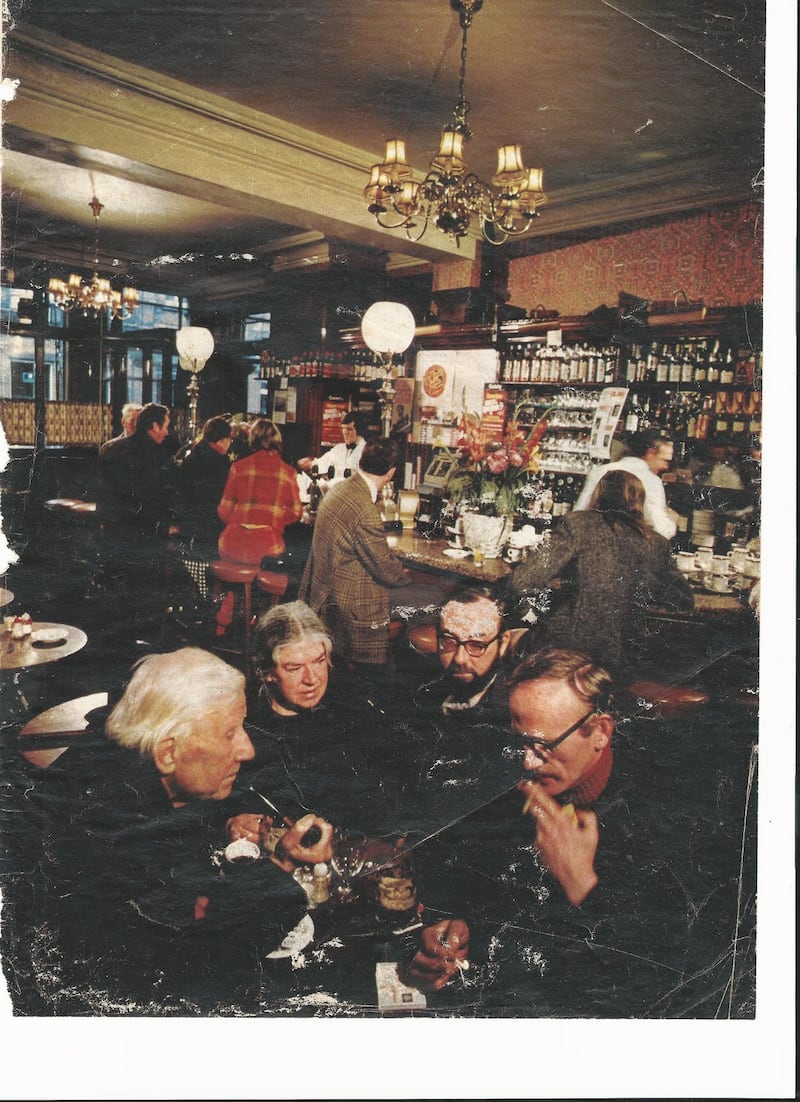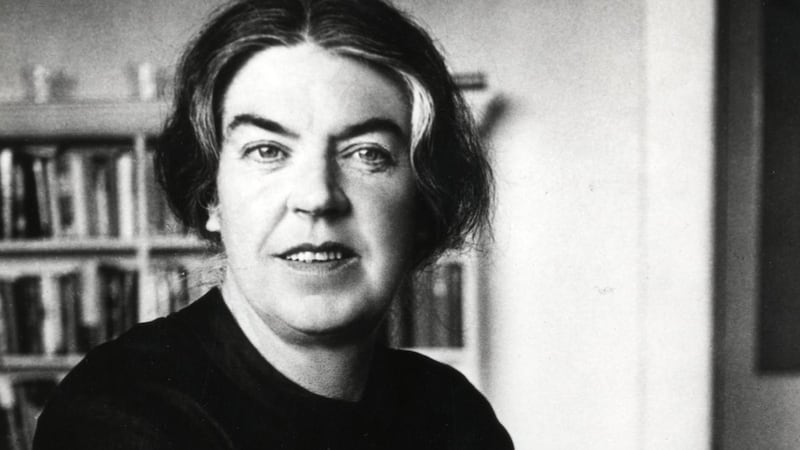There’s an irony to the news that Mary Lavin is to be honoured with the naming of a public space in her memory by Iput Real Estate, the people behind a new office development at Wilton Place, near Leeson Street. Mary Lavin, who was my grandmother, fought tooth and nail against the construction of the original building on the site, directly opposite her mews in Lad Lane.
The case she brought against Goulding Fertilisers was based on the legal principle of “ancient lights”, which gives a homeowner the right to the light that comes through their windows. Mary won the first round of the case only to lose on appeal in the Supreme Court. The office block was built, and her mews lost its ancient lights.
The mews was a coach house when she bought it in the late 1950s. She hired a young Sam Stephenson to renovate it, but the style was all hers. The black linen curtains and bare, whitewashed walls were typical of her modernist taste. The round dining-table had a pendant light hanging over it, casting her guests in a seance light.
The gatherings that took place around that table have sometimes been described as a “literary salon”, but her old friend Thomas Kilroy says Mary would have hooted laughing at the suggestion. There was a democracy and informality to the parties at the mews that were at odds with the usual sense of a salon.
“You’d just drop by if you were passing,” recalls Kilroy. “You wouldn’t know who to expect. It could have been anyone.”
Frank O’Connor and his wife Harriet were neighbours and frequent visitors. Benedict Kiely was another regular. Patrick Kavanagh came and fell asleep on the couch. Seán Ó Faoláin was there on occasion, as were Elizabeth Bowen and Padraic Colum, but it wasn’t just established writers who were welcome. Thomas Kilroy and his friend Tom McIntyre were among the many younger writers who often found themselves with their feet under Lavin’s table, as were the poets Eavan Boland and Paul Durcan, who was a friend of Mary’s middle daughter Elizabeth, and later referred to the mews in his poem No Flowers from the collection Crazy About Women.
She would throw a handful of coffee beans on the hob before guests arrived, so the place smelled like a cafe on the Boulevard Saint-Michel
But the legend of the mews as a haunt of writers is only partly accurate. There were also, on any given day, diplomats and artists and actors and academics. Maurice Harmon, the academic and critic who, along with his wife, Maura, was a lifelong friend of Mary’s, says she welcomed everybody. “You didn’t have to be somebody. If she liked you, she had you there.”
There was any number of “non-literary strays” according to Kate Bateman, who was a friend of Mary’s eldest daughter Valdi. “They were, in the best sense, bohemian gatherings,” says Bateman. “People weren’t collected by design. If you were a friend of any of the three girls, you might find yourself there.”
Bateman (then Kate Cody) was an air hostess with Aer Lingus at the time and flying in and out of New York. Mary always wanted to know where she shopped. Lord and Taylor? Bloomingdale’s? Mary was interested in everything.

Maurice Harmon remembers her as a central presence at any gathering in the mews by virtue of her strong personality and voice. She had style “in spades”, says Thomas Kilroy, “and a great feeling for continental Europe”. Her love of France and Italy gave the gatherings at the mews an exotic flavour.
“She would throw a handful of coffee beans on the hob before guests arrived, so the place smelled like a cafe on the Boulevard Saint-Michel,” says James Ryan, who married Mary’s youngest daughter, Caroline, and went on to become a writer himself. “She turned Dublin of the Sixties into our Paris,” wrote Frank Phelan, who was befriended by Mary as a young American priest living in Dublin. “It was a great continuing feast for us, around Mary Lavin’s table.”
Italian wine was sourced in bulk from the Unicorn Restaurant on Merrion Row and later from the wine society run by Count John McCormack’s son Cyril in Upper Fitzwilliam Street. Kate Bateman was stunned to see a whole bottle being poured into the coq au vin. The spaghetti Bolognese that was standard fare would, in those days, have been wildly cosmopolitan. The green salad was served in a large wooden bowl that was never washed, only wiped dry. There was cheese from Farm Produce on Baggot Street and fresh artichokes from Mary’s garden in Meath.
In later years Mary would look back on those days and say that she “made too much soup for too many people”, but there was no doubt that her hospitality became part of her persona as a writer, even if she came to believe that it depleted her energies for the work of writing.
The jumper fell into the stew, but Mary just fished it out and served up the stew without a word to her guests
Gerry Breen was a law student and a friend of Valdi’s when Mary invited him for dinner at the mews. The wine delivery hadn’t arrived from Count McCormack at the Dublin Wine Society, so Mary went rummaging in the cupboards and produced a dusty old bottle of sherry, covered in cobwebs. When she noticed that Breen wasn’t drinking his because there was a clock beetle in it, she marched over to him, saying ‘Oh, how sensitive you are.’ Then she took his glass, scooped out the clock and knocked back the drink herself.
Maurice Harmon remembers a party that was organised to welcome a distinguished Italian writer on a visit to Dublin. Mary made sandwiches, but nobody – including the distinguished Italian writer – ate them. It was only afterwards that Mary realised she’d forgotten to put in the filling. That was a story she liked to tell against herself.
Another story she like to tell was the time she left a jumper to dry on a rack above the cooker while she was making a stew. The jumper fell into the stew, but Mary just fished it out and served up the stew without a word to her guests. When one of them complimented her on it, she said there was a secret ingredient. A touch of cashmere!

“Mary had two passions,” Thomas Kilroy told me, “writing and curiosity about people.” In the mews, she could combine the two. “It was a very nourishing experience,” he said. “She fed us with food and books.” The conversation around the table was mainly, but not exclusively, literary. Kate Bateman recalls “withering” gossip, as well as some shop talk. “I remember being awestruck by a discussion between Mary and the American critic Zack Bowen on the use of the semicolon.”
Mary was by then contracted to the New Yorker and had a relationship by correspondence with some of the leading American writers of her day, such as Eudora Welty and JD Salinger. For the young acolytes who came to see her, she was a window to this thrilling literary landscape.
Word of the gatherings at Mary Lavin’s mews travelled far. In his memoir Over the Backyard Wall, Thomas Kilroy remembers visiting Flannery O’Connor in Milledgeville, Georgia, where she grilled him about the mews and the writers who met up there. It’s a lonely image: the great American writer living in invalided isolation with her mother in a farmhouse in Georgia perks up at the news of the lively literary parties taking place in Lad Lane, Dublin.
She would walk the triangle between the mews, the National Library and her favourite pit-stop in Bewley's, stopping to chat to people all along on the way
Among those who attended the parties at the mews was a young John McGahern. In a letter written in June 1960, he thanked Mary “for that wonderful evening”. “‘Although it isn’t easy to tell,” he wrote, in his beautiful, scalloped handwriting, ‘it was the second party of my life.”
His letters hint at romantic feelings for her, perhaps one-sided. McGahern was 26 at the time and staying with his sister in Howth. Mary was by then nearly 50 and a widow with three daughters. She had no shortage of experience in dealing with male admirers.
To be a woman writer, at that time, was to exist in a world populated mostly by men, but Mary had no trouble holding her own. According to Thomas Kilroy, “she took no nonsense from anyone”. The mews was a household of women and a world apart from the aggressively male literary culture that flourished at the time in Dublin’s pubs. There’s a photograph of Mary sitting in Neary’s with Austin Clarke, Thomas Kinsella and Thomas Kilroy, but it’s an anomaly.
“Mary Lavin didn’t frequent pubs,” Nuala O’Faolain would write, “but she wasn’t a housewife either.” O’Faolain was one of the few female writers who came to the mews, so it’s interesting to see Mary Lavin through her eyes. To her, Mary was an exceptional woman, a widow with three children who had a town house and a country house and who “could run things her way”.
In her memoir, Are You Somebody?, Nuala O’Faolain acknowledges Mary’s support in loaning her money to re-sit her exams and thereby complete her degree.
Mary also encouraged Elizabeth Cullinan, a young American short story writer who spent three years in Ireland in the early 1960s and, by her own admission, haunted the mews. She would later describe the life of Mary and her girls, as she witnessed it, as “intense and improvisational”. At one point there were mice in the mews, so Mary and the girls moved into Buswell’s Hotel and left the cat to take care of the situation – “which she did,” wrote Cullinan.

The fictional character of Maura in Cullinan’s story Maura’s Friends is a portrait of Mary as she was then, a widow trying to dispel the sadness in her life by surrounding herself with people. Cullinan described Mary’s face as “beautifully expressive of her whole nature, which was shrewd, generous, vigorous and fragile, querulous and kind and, above all, welcoming”.
“She was hugely gregarious,” says Thomas Kilroy. “She was constantly meeting and chatting to people.” He had a sister working in Tyler’s shoes on Grafton Street and only discovered by chance that she also knew Mary. Mary had been into the shop and got the sister’s life story.
Mary would walk the triangle between the mews, the National Library and her favourite pit-stop in Bewley’s, stopping to chat to people all along on the way. In her signature black clothing, with her long grey hair always in a messy bun, she became one of Dublin’s familiar sights.
The news that a part of the city is now to be dedicated to her is a fitting honour and an important step in keeping her legacy alive, not just as a writer but as a living part of the city’s history.
Mary Lavin survives in Dublin’s folk memory as a young mother working by the fire in Bewley’s while her children do their homework. As a working woman, drafting her stories at a desk in the National Library. As a member of a community of writers, a ready mentor and generous host, serving up exotic European fare to all comers at her mews in Lad Lane. It’s a legacy that Iput do well to honour, a reminder of what a city is to the people living in it and what they are to it.

The public square that will be dedicated to Mary lies at the front of the new office development facing onto the small triangular park at Wilton Place. Iput also proposes to commission a sculpture dedicated to Mary, to be installed at the site on completion. Mary’s sculpture will have a clear view of her one-time guest, Paddy Kavanagh, who is forced to sit forever on a bench on the canal now that he can no longer crash on her couch. She will be just a hop, skip and a jump from Lad Lane, where her mews lay in the shadow of the building she so vigorously opposed.
In moving to the sunny side of the building, I like to think Mary Lavin has finally secured her “ancient lights”.

















